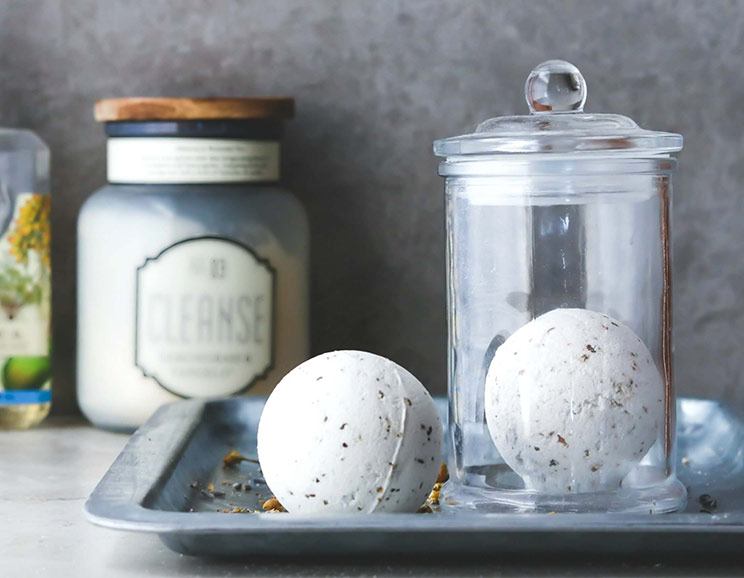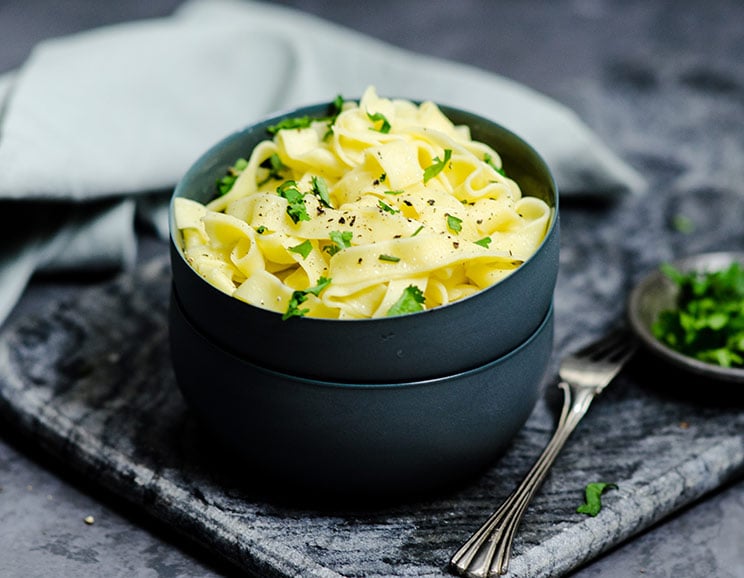Learn the trick to the fluffiest muffins, the crunchiest crackers and the heartiest pot pies in this gluten-free flours guide!
Whether you follow a Keto, Paleo or AIP diet, there is no shortage of gut-friendly flours for you to have in your baking arsenal. From starchy sauce thickeners like arrowroot powder to nutty almond flour to create homemade pie crust, you’ll never be empty-handed with this handy guide for replacing flour in your favorite recipes.
Here, we list 10 of the most common gluten-free flours that you can use in place of regular flour while baking your favorite non-Paleo recipes. Keep in mind that some of these flours are more absorbent than others, meaning that you’ll need to adjust the amount of liquids added or flour used. You definitely don’t want to attempt a 1:1 ratio with coconut flour!
Love Coconut Flour Recipes? Then you’ll love our FREE Coconut Flour Recipes.
Click here to get your FREE copy of our delicious Coconut Flour Recipes!
While you can buy many of these gluten-free flours at health food stores, know that many of these flours can be made right in your own kitchen! With a high-quality food processor or coffee grinder, it’s easy to grind nuts, seeds, and roots down to a fine texture for a super-fresh flour.
Coconut Flour

This spongy and fiber-rich flour works best for sweet recipes, as the coconut aroma can be strong. When using coconut flour, it’s important to increase the eggs to compensate for the absorbency of coconut flour – about 1 egg for every ¼ cup coconut flour should do the trick!
- Replacement Ratio: 1 cup coconut flour : 4 cups wheat flour
- Flavor: Subtly sweet
- What It Does: Adds a fluffy texture
- Use It to Make: Cookies, quick bread, cakes, brownies
Almond Flour

Fine almond flour and coarse almond meal are both great replacements for traditional flour. Almond meal imparts more of a chewy, nutty texture while blanched almond flour makes for lighter baked goods.
- Replacement Ratio: 1 cup almond flour : 1 cup wheat flour
- Flavor: Nutty and mild
- What it Does: Adds a chewy, fluffy texture to baked goods, moisture
- Use It to Make: Pizza crusts, muffins, bread, pie crusts
Macadamia Nut Flour

If you like macadamias more than almonds, this flour is for you. It can be used just like almond flour to impart a mildly chewy texture to baked goods.
- Replacement Ratio: 1 cup macadamia flour : 1 cup wheat flour
- Flavor: Nutty and mild
- What It Does: Adds chewy, moist texture
- Use It to Make: Coating for fish and chicken, cookies, pie crusts, crackers
Cashew Flour

This mild flour is versatile for use in both sweet and savory recipes. Rich in protein and minerals, cashew flour is a great option for upping the health benefits of recipes.
- Replacement Ratio: 1 cup cashew flour : 1 cup wheat flour
- Flavor: Mildly nutty
- What It Does: Adds moisture and chewiness
- Use It to Make: Cookies, cakes, pancakes, pizza, and crusts
Hazelnut Flour

The nuttiest of nut flours, hazelnut flour is a terrific option for sweet dessert recipes. Similar to almond flour and macadamia nut flour, it adds a chewy texture to baked goods, but with a stronger nutty flavor.
- Replacement Ratio: 1 cup hazelnut flour : 1 cup wheat flour
- Flavor: Strong and buttery
- What it does: Adds hearty texture to recipes
- Use it to Make: Crusts for dessert bars and tarts, sweet bread
Cassava Flour

This exotic flour is made from yuca root, a tuber from the same family as taro and yams. Low in calories and sugar, cassava is excellent for maintaining normal blood sugar levels. Cassava flour is also pretty absorbent, so you’ll want to use just a little less than you normally would.
- Replacement Ratio: 3 cups cassava flour : 4 cups wheat flour
- Flavor: Mild and subtle
- What it does: Produces airy baked goods.
- Use it to Make: Pancakes, brownies, tortillas, cookies, biscuits
Plantain Flour

Made from dehydrated green plantains, this starchy flour can be used for slightly denser baked goods. Plantain flour doesn’t crumble like many nut flours tend to, making them ideal for pancakes and tortillas.
- Replacement Ratio: 3 cups plantain flour : 4 cups wheat flour
- Flavor: Subtle and earthy
- What It Does: Adds density
- Use It to Make: Bread, pancakes, tortillas, brownies
Tigernut Flour

This nut-free flour is a derived from a root vegetable, making it a terrific option for those with nut allergies. Its slightly grainy texture adds crunch to foods like cookies, crackers and this coconut bread, and its natural sweetness lets you get away with cutting back on added sugars. As a bonus: Tiger nuts contain gut-friendly prebiotics, which help feed the good bacteria in the belly.
- Replacement Ratio: 1 cup tigernut flour :1 cup wheat flour
- Flavor: Sweet and nutty
- What It Does: Adds crunch and chewiness to recipes
- Use It to Make: Brownies, crusts, cookies, crackers
Sweet Potato Flour

Just like fresh sweet potatoes, this nutrient-dense flour adds fiber and beta-carotene to recipes. Sweet potato flour is less absorbent than other flours, so when using it as a replacement to flour, reduce the liquid by 15-20%.
- Replacement Ratio: 1 cup sweet potato flour :1 cup wheat flour
- Flavor: Light and sweet
- What It Does: Thickens sauces and gravies
- Use It to Make: Donuts, cakes, cookies, sauces, and gravies
Sunflower Seed Flour

Sunflower seed flour – or “sun-flour” – is a fiber-rich alternative perfect for those with nut allergies. You can also buy (or make) sun-flour at a fraction of the cost of most nut flours.
- Replacement Ratio: 1 cup sun-flour :1 cup wheat flour
- Flavor: Earthy and nutty
- What It Does: Adds moisture and chewiness
- Use It to Make: Pancakes, muffins, quick bread
Flours That Act Like Starches:

Starchy flours like tapioca and arrowroot don’t rank high in the nutrition department, but they still have their place in Paleo cooking and baking. Because of their high starch content, they can be used to create elasticity and prevent crumbling. They are also great for thickening sauces and gravy instead of cornstarch or flour.
When using as a thickener, be sure to make a slurry with cold water. Add 1 tablespoon of tapioca or arrowroot powder for each cup of water, whisk well, then add to the sauce.
While these two starches have an almost indistinguishable texture, they have some slight differences when it comes to their temperaments in certain recipes. Tapioca can withstand higher heat for an extended time while holding its thickening power. Arrowroot, on the other hand, tends to break down when heated for extended time periods.
Tip: These starchy flours are best used in combination with other flours when baking, as they can get gummy when used alone.
Tapioca Starch
Tapioca starch comes from the yuca plant, but unlike cassava flour, it is made using just the dried starch from yuca.
Tips when using tapioca starch:
– Do not use with high acidic foods like vinegar or lemon juice as they impair its ability to thicken.
– Can safely be heated for a long time
- Flavor: Neutral
- What It Does: Thicken, adds elasticity
- Use It to Make: Tortillas, coating meat, crepes, soups, sauces, gravies
Arrowroot Starch
Tips:
– Can be added to acidic foods to maintain thickness
– Should be added only at the end of high-heat cooking
- Flavor: Neutral
- What It Does: Thickens, stiffens and adds elasticity
- Use It to Make: Tortillas, crepes, to thicken soups, sauces, gravies
Tip: For the ultimate gluten-free, all-purpose flour, try a mix of the above flours. Adding a starch like cassava or arrowroot to non-starchy flours (like almond flour) will help create a texture closer to an all-purpose flour.
Try replacing 1 cup of regular flour with ⅔ cups almond flour + ⅓ cup arrowroot flour in your next batch of muffins and watch how fluffy they come out of the oven!
Read This Next: 8 Butter Substitute Ideas to Cook, Bake and Fry Anything




 SleepyTime Bath Bomb Recipe
SleepyTime Bath Bomb Recipe









Show Comments